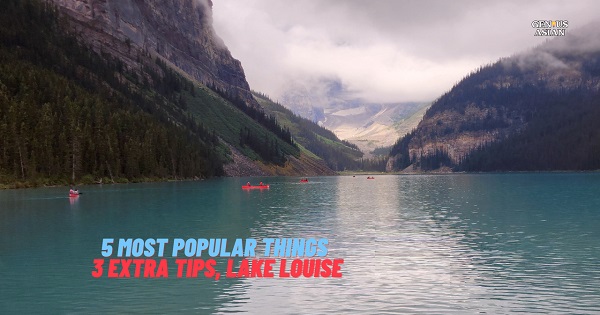https://youtu.be/bNCUVTzidIQ Lake Louise is the most visited lake in the Banff National Park and Jasper National Park area. Easy ways to get to Lake Louise are via the hop-on hop-off from Banff or on a Lake Louise tour from Banff or Calgary.
Have you heard of “The Lake Louise Window”? The Lake Louise Window was taken by photographer Galen Rowell in 1979. The photo shows the iconic Fairmont Chateau Lake Louise hotel reflected in the calm waters of Lake Louise. It was sold for $1.2 million in 2014, making it one of the most expensive photographs ever sold.
You may also have heard that the stone railing came from the bottom of the ocean, but why is that? The stone used for the stair railings at the Fairmont Chateau Lake Louise in Canada is Banff Jasper limestone, which is a type of sedimentary rock that was formed from the remains of marine organisms that lived on the bottom of the ocean millions of years ago. This type of rock is known for its coolness to the touch, even in hot weather, because it has a high specific heat capacity. This means that it takes a lot of energy to raise the temperature of the stone, so it stays cool even when the air temperature is warm. The Banff Jasper limestone used for the stair railings at the Fairmont Chateau Lake Louise was quarried from a nearby location called the Mount Royal Quarry.
Has anyone provided to you the detailed scientific explanation on the color of the water in the lake? The color of the water in the lakes is affected by the wavelength of the visible light spectrum that is reflected or absorbed by the chemical compounds in the water. The visible light spectrum consists of different colors that have different wavelengths and energies. The shorter the wavelength, the higher the energy, and vice versa. The colors of the visible light spectrum range from violet (the shortest wavelength and highest energy) to red (the longest wavelength and lowest energy). The other colors in between are indigo, blue, green, yellow, and orange.
The chemical compounds that change the color of the water from blue to green or deeper color are mainly related to the amount and size of glacial rock flour suspended in the water. Rock flour is the fine-grained sediment produced by the erosion of glaciers on the underlying bedrock. The smaller the rock flour particles, the more they reflect blue light and give the water a turquoise hue. The larger the particles, the more they reflect green light and give the water a greenish tint.
Calcium carbonate (CaCO₃) and magnesium bicarbonate [Mg(HCO₃)₂] can also influence the color of water in various ways:
Turbidity and Color: When calcium carbonate precipitates out of water, it can create a cloudy or milky appearance due to the presence of tiny solid particles suspended in the water. This is especially the case in areas with hard water where the concentration of calcium and magnesium ions is high.
Reflection and Scattering: Suspended particles of calcium carbonate can scatter light, similar to how rock flour in glacial lakes does. The size and concentration of these particles can influence the color. Typically, smaller particles scatter shorter wavelengths of light (blue) more than longer wavelengths.
The reason why smaller particles reflect blue light and larger particles reflect green light is because of the scattering effect of light by the particles. Scattering is the process by which small particles in a medium deflect or diffuse light in different directions. The amount of scattering depends on the ratio of the particle size to the wavelength of light. When light encounters a particle that is much smaller than its wavelength, such as a molecule of air or a tiny grain of rock flour, it undergoes Rayleigh scattering, which scatters more short-wavelength light (such as violet and blue) than long-wavelength light (such as yellow and red). This is why the sky appears blue on a clear day, as the air molecules scatter more blue light than other colors. Similarly, when light encounters a particle that is comparable to its wavelength, such as a larger grain of rock flour or a droplet of water, it undergoes Mie scattering, which scatters all wavelengths of light equally. This is why clouds appear white on a sunny day, as the water droplets scatter all colors of light equally.
However, when light encounters a particle that is much larger than its wavelength, it undergoes reflection
Chapters
00:00 Lake Louise ranked number among other lakes
00:35 Map of Lake Louise and Banff Area
01:17 Fairmont Chateau Lake Louise famous Window Photo
01:57 Fairmont Chateau Lake Louise Jasper limestone stair railings
02:49 Hotel backdrop – Mount Victoria, glacier runoff & Lake
03:07 Lakeshore trail
03:34 Video clip from end of lake, glacier runoff
03:54 Detailed scientific explanation of different water color in lakes
06:08 Rock climbing
06:23 Rent canoe from boat house or Hike

